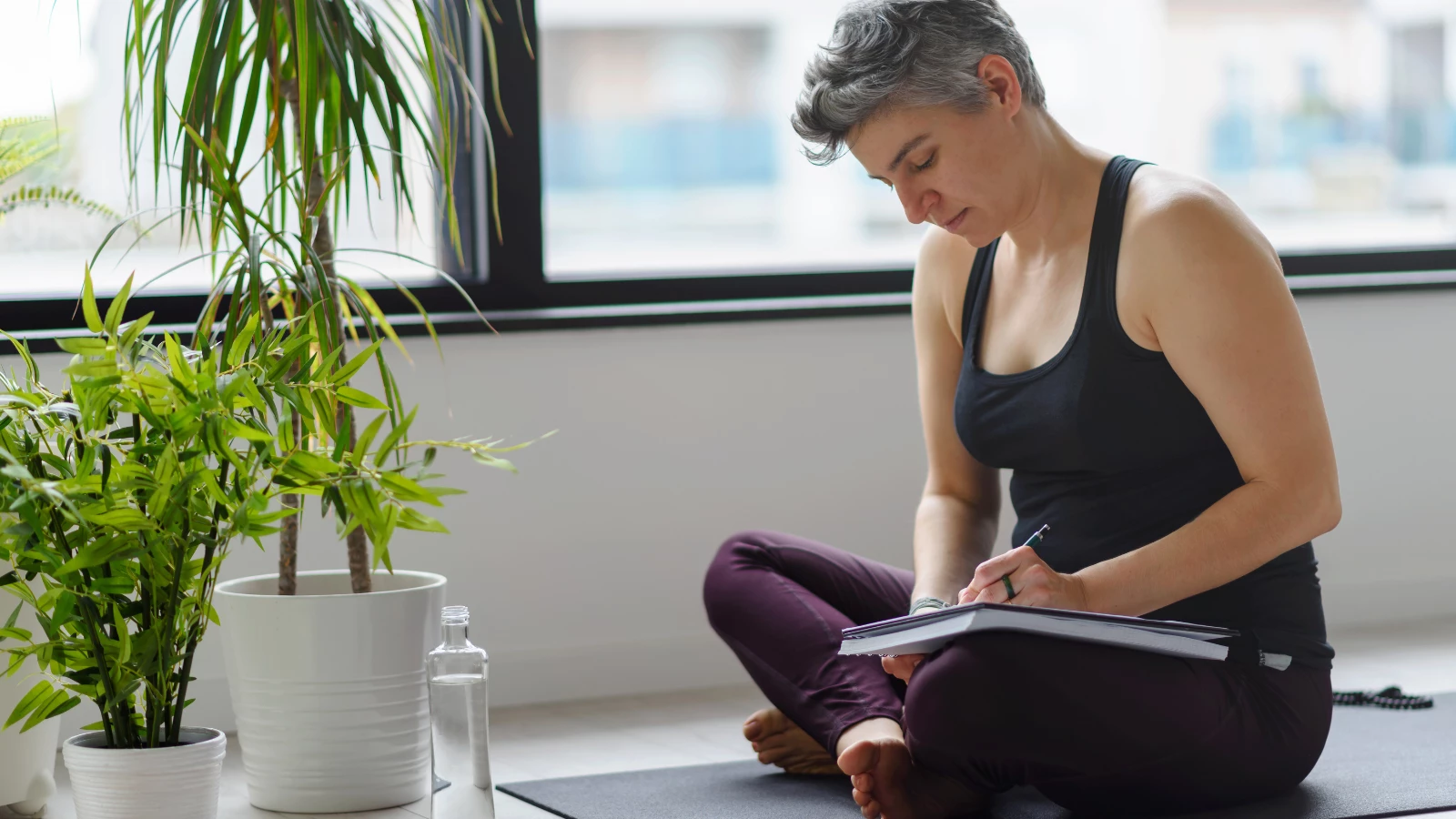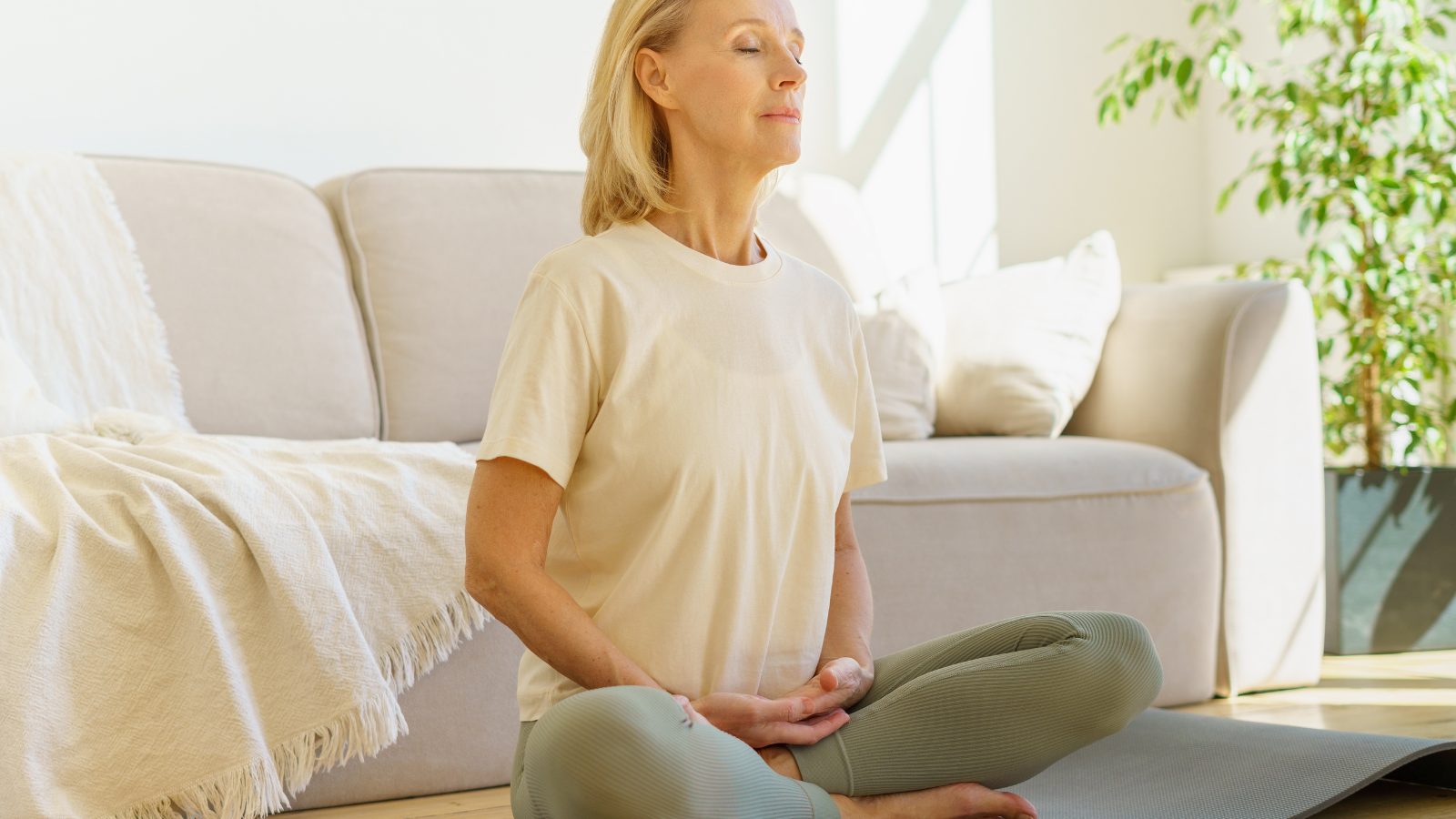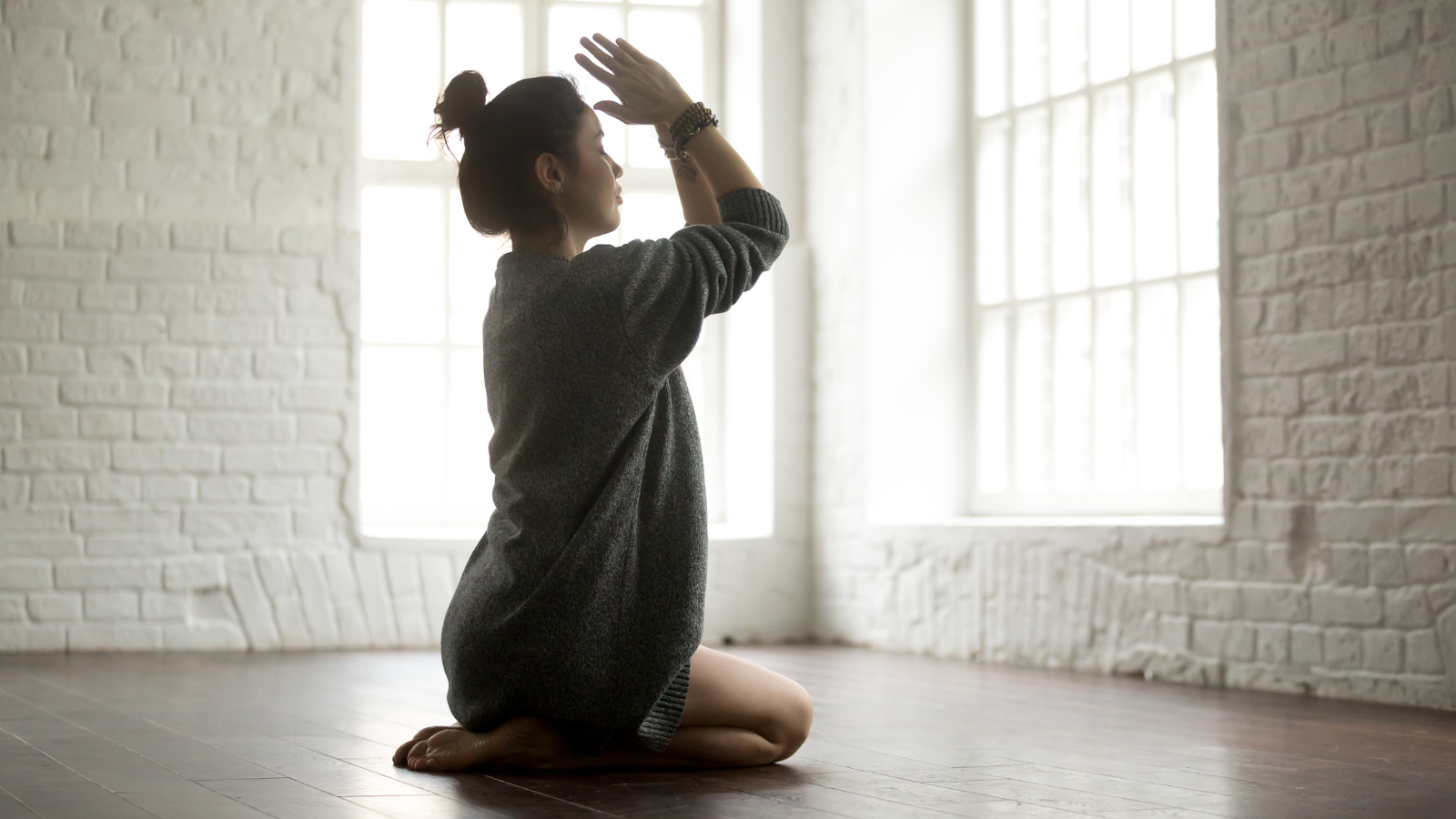4 Ways to Prevent Anxiety with Yoga

Article At A Glance
Yoga practice offers plenty of ways to reduce anxiety—restorative, meditation, certain breathing practices—and there’s lots of information available. I realized lately that for people who tend to have anxiety, preventing anxiety from developing is just as, if not more, important. So here are my latest thoughts about how to use yoga to prevent anxiety, all of which I—yes, I’m one of those people who tend to experience anxiety—have practiced myself.
4 Ways Yoga Can Help You Prevent Anxiety
1. Manage Your Stress Levels
Chronic stress is one of the main causes of anxiety. That’s because when your stress levels are always high, your fight-flight-or-freeze response causes you to be “hypervigilant.” This means, among other things, that you are constantly on alert for possible dangers, whether in the present, in the future, or both. So you’re generally feeling fearful and your mind is full of anxious thoughts. Reducing your baseline stress levels by regularly practicing yoga for stress management can change both how you feel and what types of thoughts you’re having, which reduces anxiety levels overall. I know about this because I’ve been there myself!
2. Practice Self-Inquiry
“Meditation, mindful movement, journaling, and creative projects are all practices that help us to be present and observe what arises in our thinking and in our bodies. We become our own psychiatrists, experts on our own minds. We get some distance from our thoughts, develop a healthy skepticism, and learn which thoughts lead to suffering. We become less reactive, more thoughtful.” — Dr. Scott Lauzé
One of the most valuable things you can do to prevent anxiety is to learn about how anxiety affects your body and your mind. When you understand what physical, emotional, and mental symptoms anxiety causes for you. Symptoms might include racing thoughts, feelings of panic, rapid breathing, insomnia, digestive problems, headaches, and so on. When you understand your triggers, you’ll be able to notice warning signs that anxiety is starting to develop. You can then take immediate action to prevent a full-blown episode. Those actions may include temporarily changing your life circumstances by dialing back activities that cause stress and changing your yoga practice by focusing more on stress management.
When you practice self-inquiry, focus on learning: What do you think when you start to feel anxious? What do you feel in your body when you start to feel anxious? Are there certain things that trigger your anxiety? What are your symptoms of anxiety?
How to Practice Self-Inquiry to Help Prevent Anxiety
Here are a few ways to practice self-inquiry:
- Pause briefly to listen. In the brief moment between when you experience anxiety and then react to it, you have the opportunity to pause briefly. For both yoga practitioners and for Buddhists, this moment is considered so important for responding skillfully to thoughts and emotions that it is called a “sacred “or “precious” pause. To take the precious pause, you step back and observe what you’re feeling—along with any associated physical symptoms—without reacting to them.
- Practice yoga poses to listen. Some of you may find it easier to observe emotions when you are moving and engaged with your body as well as your mind. To do this, when you practice your yoga poses, allow yourself to notice whatever emotions come up during your practice as well as the physical sensations that are associated with them. As always, listening in your yoga practice means observing without reacting or making judgments.
- Dedicate time for self-inquiry. A dedicated self-inquiry session can be any amount of quiet time you set aside to work on self-reflection. You can do this by:
- Writing in a journal.

- Using drawing, painting, or any creative project to explore your thoughts and feelings.
- Taking a walk and allowing yourself to explore your thoughts and feelings in a relaxed and unstructured way.
- Talk through some issues with the right friend, who can listen to you non-judgmentally and ask helpful questions.
- Practice mindfulness meditation to listen. Those of you who have experience with mindfulness meditation can spend time focusing in your meditation on anxious feelings and sensations in your body and anxious thoughts in your mind to learn more about yourself and how anxiety is triggered in you and how it affects you. However, this is something you should only do if the practice does not make you feel worse. If you’re practicing and notice that you are feeling worse, it’s a good idea to switch away from your anxiety by meditating on something neutral that you know calms you, such as your breath or a mantra.
3. Quiet Your Mind
When you’re feeling relatively calm, that is, when you’re not in the middle of a period of acute anxiety, this is a good time to cultivate two skills for quieting your mind that can help reduce your baseline stress levels and that, equally important, you can later rely on when you are starting to feel anxious. It’s like adding new tools to your emergency toolkit. I like having both calming breath practices and concentration meditation in my toolkit because I can do them in many situations where yoga poses are not possible. For example, I’ve done calming breath practices while having uncomfortable dental and medical procedures.
Calming Breath Practices: Yogic breath practices where you lengthen your exhalation can be very calming when you’re feeling stressed out and/or anxious. But it is best to learn them when you’re not feeling particularly anxious and to practice them regularly so you’re very familiar with them.
Concentration Meditation: If you’re already experienced practicing yogic concentration meditation, where you focus exclusively on your breath, an image, or a mantra, this can help quiet your mind when you’re feeling anxious. I personally find a simple mantra of “Shanti, Shanti, Shanti” very helpful because the mantra, which I mentally recite on my exhalation, gives my mind more to focus on.
4. Become Comfortable with Uncertainty

Taking a “yogic” approach to life means accepting the ups and downs of life with a measure of equanimity. To do this you often need to change the way you think. So many of us have been raised to believe that we can control our own destinies and we have internalized this belief. So, becoming more comfortable with uncertainty often means adopting a different mindset.
One of the most important principles of yoga is that change and uncertainty are intrinsic aspects of life. The material world (prakrti), which includes your body-mind as well as other beings and external objects, is by its nature ever-changing. As T.K.V. Desikachar says:
“Although in yoga everything we see and experience is true and real, all form and all content are in a constant state of flux. This concept of continual change is known as Parinamavada.” — from The Heart of Yoga
Because anxiety is often associated with being in changing or uncertain circumstances, accepting this truth that the material world is impermanent can be really beneficial for those with anxiety. After all, anxiety is typically focused on panic or fear about how situations may or may not play out. I’ve found that just studying yoga philosophy that explores this topic can be helpful. The Bhagavad Gita is particularly relevant because the hero in the story, Arjuna, is in a state of anguish due to the possible “outcomes” of his actions. But you may find other yoga texts helpful as well.
You can also work directly with your anxious thoughts by practicing detachment. This will help you let go of anxious thoughts you’re having that are not serving you, which allows you to become more comfortable with uncertainty.
5 Ways to Prevent Anxiety by Letting Go of Anxious Thoughts
Here is a summary of five ways to let go of anxious thoughts:
- Use Your Breath: You can use your breath at any time to release an unhelpful thought or emotion with your exhalation. Simply inhale and then breathe out that thought or emotion with your exhalation. If needed, you can repeat with more breaths.
- Picture an Action: You can use a mental image that says “let go” to release unhelpful thoughts and emotions. Some ideas include moving your thoughts or emotions into a trash can like you do on your computer or putting it on a log and watching it float down a river.
- Recite a Phrase: Use a phrase—a quote from a yoga text or from anywhere else, or something that you make up—that says “letting go” to you.
- Tune into Your Senses: One way to let go of thoughts or emotions regarding the past or future is to bring yourself into the present by immersing yourself in a sensory experience, such as exploring all aspects of a flower, a cup of tea, a peach, or a book (did you ever smell a book?).
- Cultivate the Opposite: The sutra II.33 in Patanjali’s Yoga Sutras recommends the practice Pratipaksha Bhavanam, which means “cultivate the opposite” or “cultivate counteracting thoughts,” as a way to let go of negative thoughts and emotions. With this practice, you intentionally think of an opposite thought that is more helpful than the original thought or emotion.
For example, maybe you find yourself thinking, “I can’t deal with this!” You could intentionally follow that with a thought like, “I can be okay with this.” This practice has long-term benefits because you spend more time thinking positive thoughts and feeling positive emotions, which can start a new habit for you.
Also, read...
Research Studies Document Benefits of Yoga for Depression
Looking for Ways to Cope with Anxiety? How Yoga May Help
Preventing Chronic Disease: Yoga May Alter Gene Expression Linked to Inflammation
Related courses
Breath as Medicine: Yogic Breathing for Vital Aging
Yoga and Myofascial Release: Releasing Chronic Tension with the Bodymind Ballwork Method
Yoga and Detoxification: Tips for Stimulating Lymphatic Health

Nina Zolotow, RYT 500, the author of the forthcoming book “Yoga for Times of Change” and the Editor-in-Chief of the Yoga for Healthy Aging blog, is both a yoga writer and a yoga teacher. She trained to be a yoga teacher at The Yoga Room in Berkeley, California, has studied yoga therapy with Shari Ser and Bonnie Maeda, and is especially influenced by the teachings of Donald Moyer. She also studied extensively with Rodney Yee and is inspired by the teachings of Patricia Walden on yoga for emotional healing. Her special area of expertise is yoga for emotional well-being (including yoga for stress, insomnia, depression, and anxiety). She teaches workshops and series classes on yoga for emotional well-being, stress management, better sleep, home practice, and cultivating equanimity.
Nina is the co-author with Baxter Bell of Yoga for Healthy Aging: A Guide to Lifelong Well-Being and co-author with Rodney Yee of Yoga: The Poetry of the Body (with its companion 50 Card Practice Deck) and Moving Toward Balance. She is also the author of numerous articles on yoga and alternative medicine.






